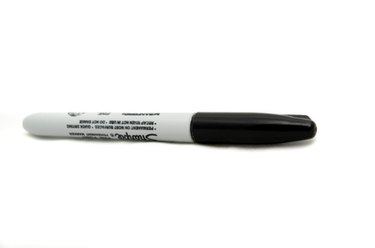
By definition, a permanent marker's "marks" will remain, even when confronted with water or other substances. However, even a permanent marker can't promise to last forever. Writing on wood, for example, that is left outside to the elements might only last a few months, but will certainly last longer than any of its water-soluble counterparts. Permanent inks have been around for thousands of years and some of them, particularly India and Sumi inks, have remained permanent. Developments in pigments and chemicals have ensured that modern permanent inks and markers last.
Ingredients
Video of the Day
Permanent markers used to contain ingredients like xylene that could be considered addictive to smell. The Sanford Company, which created the popular "Sharpie" brand permanent markers, the markers and inks created by Sanford use combinations of various pigments and dyes as well as the chemicals n-propanol (related to rubbing alcohol), n-butanol (a flammable hydrocarbon like gasoline) and n-diacetone alcohol (a solvent). Pigments are usually used, though, in permanent markers because dye is water soluble.
Video of the Day
Functions
A permanent marker is useful for many projects. Because permanent markers generally adhere to all types of surfaces from plastic to wood to paper, you can label your child's toys for the beach; write your name on your luggage; create a sign; label items for your freezer (wrapped in plastic or foil first, of course). Permanent markers come in many different colors now, so color-coding items is quick and easy.
Types
Permanent markers come in many different sizes and colors from very fine tips for writing on regular paper or in small areas, to large, thick tips that are good for writing on boxes and crates. There are also chisel-tip markers, retractable markers that do not require caps and two-sided markers with a fine-tip on one side and a thick one on the other.
Stain Removal
Permanent markers are permanent, but sometimes we wish they weren't. When permanent marker gets written somewhere we wish it hadn't, like a hard surface, try using a little toothpaste to remove the mark. Rubbing alcohol and hairspray saturated on an ink fabric stain and carefully blotted, then washed, should get the stain out.
Warning
Permanent markers can cause allergic reactions particularly if used on skin or near your eyes or nose. If you get marker on your skin and begin to have an allergic reaction, try and wash the area with mild soap and water. This may help alleviate any itching or burning. If this does not work, you may want to seek out a physician. Rubbing alcohol has been known to get marker off skin, but if you are having a reaction, you may not want to add any more irritants to your skin.